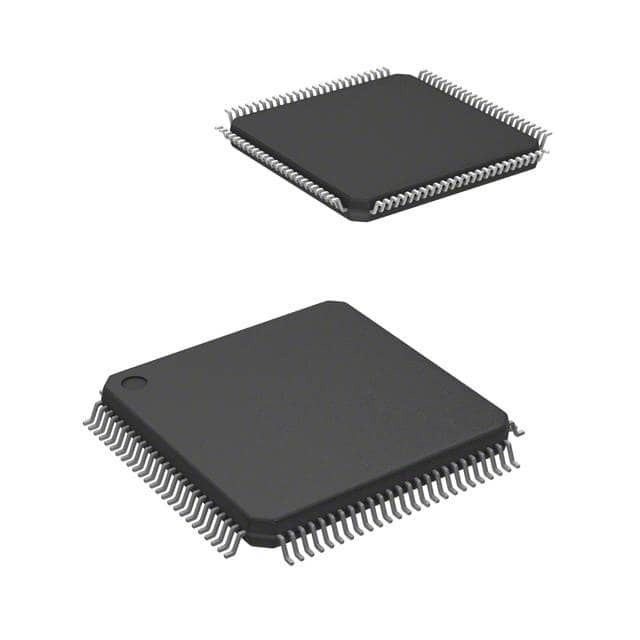Xem thông số kỹ thuật để biết chi tiết sản phẩm.

STM32F217VGT6TR
Product Overview
- Category: Microcontroller
- Use: Embedded systems, Internet of Things (IoT) devices, industrial applications
- Characteristics: High-performance, low-power consumption, extensive peripheral set
- Package: LQFP-100
- Essence: ARM Cortex-M3 core microcontroller
- Packaging/Quantity: Tape and reel, 2500 units per reel
Specifications
- Core: ARM Cortex-M3
- Clock Speed: Up to 120 MHz
- Flash Memory: 1 MB
- SRAM: 128 KB
- Operating Voltage: 2.0V - 3.6V
- I/O Pins: 80
- Communication Interfaces: UART, SPI, I2C, USB, CAN, Ethernet
- Analog Inputs: 16 channels, 12-bit ADC
- Timers: 16-bit and 32-bit timers
- Operating Temperature: -40°C to +85°C
Pin Configuration
The STM32F217VGT6TR microcontroller has a total of 100 pins. The pin configuration is as follows:
- Pins 1-4: VDDA, VSSA, OSCIN, OSCOUT
- Pins 5-8: NRST, VDD, VSS, VBAT
- Pins 9-16: PA0, PA1, PA2, PA3, PA4, PA5, PA6, PA7
- Pins 17-24: PB0, PB1, PB2, PB3, PB4, PB5, PB6, PB7
- Pins 25-32: PC0, PC1, PC2, PC3, PC4, PC5, PC6, PC7
- Pins 33-40: PD0, PD1, PD2, PD3, PD4, PD5, PD6, PD7
- Pins 41-48: PE0, PE1, PE2, PE3, PE4, PE5, PE6, PE7
- Pins 49-56: PF0, PF1, PF2, PF3, PF4, PF5, PF6, PF7
- Pins 57-64: PG0, PG1, PG2, PG3, PG4, PG5, PG6, PG7
- Pins 65-72: PH0, PH1, PH2, PH3, PH4, PH5, PH6, PH7
- Pins 73-80: PI0, PI1, PI2, PI3, PI4, PI5, PI6, PI7
- Pins 81-88: PJ0, PJ1, PJ2, PJ3, PJ4, PJ5, PJ6, PJ7
- Pins 89-96: PK0, PK1, PK2, PK3, PK4, PK5, PK6, PK7
- Pins 97-100: VSS, VDD, BOOT0, NRST
Functional Features
- High-performance ARM Cortex-M3 core for efficient processing
- Extensive peripheral set including UART, SPI, I2C, USB, CAN, and Ethernet interfaces
- 16-channel, 12-bit ADC for accurate analog measurements
- Multiple timers for precise timing control
- Low-power consumption for energy-efficient applications
- Wide operating temperature range for industrial use
Advantages and Disadvantages
Advantages: - High-performance microcontroller suitable for demanding applications - Extensive peripheral set allows for versatile connectivity options - Low-power consumption enables energy-efficient designs - Wide operating temperature range makes it suitable for industrial environments
Disadvantages: - Limited availability of alternative models with similar specifications - Higher cost compared to lower-end microcontrollers
Working Principles
The STM32F217VGT6TR microcontroller operates based on the ARM Cortex-M3 core architecture. It executes instructions stored in its flash memory and interacts with various peripherals to perform specific tasks. The microcontroller can communicate with external devices through its UART, SPI, I2C, USB, CAN, and Ethernet interfaces. It can also process analog signals using its built-in ADC and generate precise timing using its timers.
Detailed Application Field Plans
The STM32F217VGT6TR microcontroller finds applications in various fields, including:
- Industrial automation: Control systems, motor drives, and robotics.
- Internet of Things (IoT): Smart home devices, wearable technology, and sensor networks.
- Automotive: Infotainment systems, engine control units, and advanced driver-assistance systems.
- Medical devices: Patient monitoring systems, diagnostic equipment, and medical imaging.
Liệt kê 10 câu hỏi và câu trả lời thường gặp liên quan đến ứng dụng STM32F217VGT6TR trong giải pháp kỹ thuật
Sure! Here are 10 common questions and answers related to the application of STM32F217VGT6TR in technical solutions:
Q: What is the STM32F217VGT6TR microcontroller?
A: The STM32F217VGT6TR is a high-performance microcontroller based on the ARM Cortex-M3 core.Q: What are the key features of the STM32F217VGT6TR?
A: Some key features include a 32-bit CPU, up to 512KB flash memory, 128KB RAM, multiple communication interfaces, and various peripherals.Q: What applications can the STM32F217VGT6TR be used for?
A: It can be used in a wide range of applications such as industrial control systems, motor control, medical devices, and consumer electronics.Q: How do I program the STM32F217VGT6TR microcontroller?
A: You can program it using various development tools like STM32CubeIDE, Keil MDK, or IAR Embedded Workbench.Q: Can I use the STM32F217VGT6TR for real-time applications?
A: Yes, the microcontroller's Cortex-M3 core provides excellent real-time performance and deterministic behavior.Q: What communication interfaces are available on the STM32F217VGT6TR?
A: It has interfaces like UART, SPI, I2C, USB, Ethernet, CAN, and more, making it suitable for various connectivity requirements.Q: Does the STM32F217VGT6TR support analog functions?
A: Yes, it has built-in analog-to-digital converters (ADCs) and digital-to-analog converters (DACs) for analog signal processing.Q: Can I expand the STM32F217VGT6TR's capabilities with external peripherals?
A: Yes, the microcontroller has GPIO pins that can be used to interface with external sensors, displays, or other peripherals.Q: Is the STM32F217VGT6TR suitable for low-power applications?
A: Yes, it offers various power-saving modes and features like sleep mode, standby mode, and low-power timers.Q: Where can I find more information about the STM32F217VGT6TR microcontroller?
A: You can refer to the official documentation provided by STMicroelectronics, including datasheets, reference manuals, and application notes.
Please note that these answers are general and may vary depending on specific use cases and requirements.

